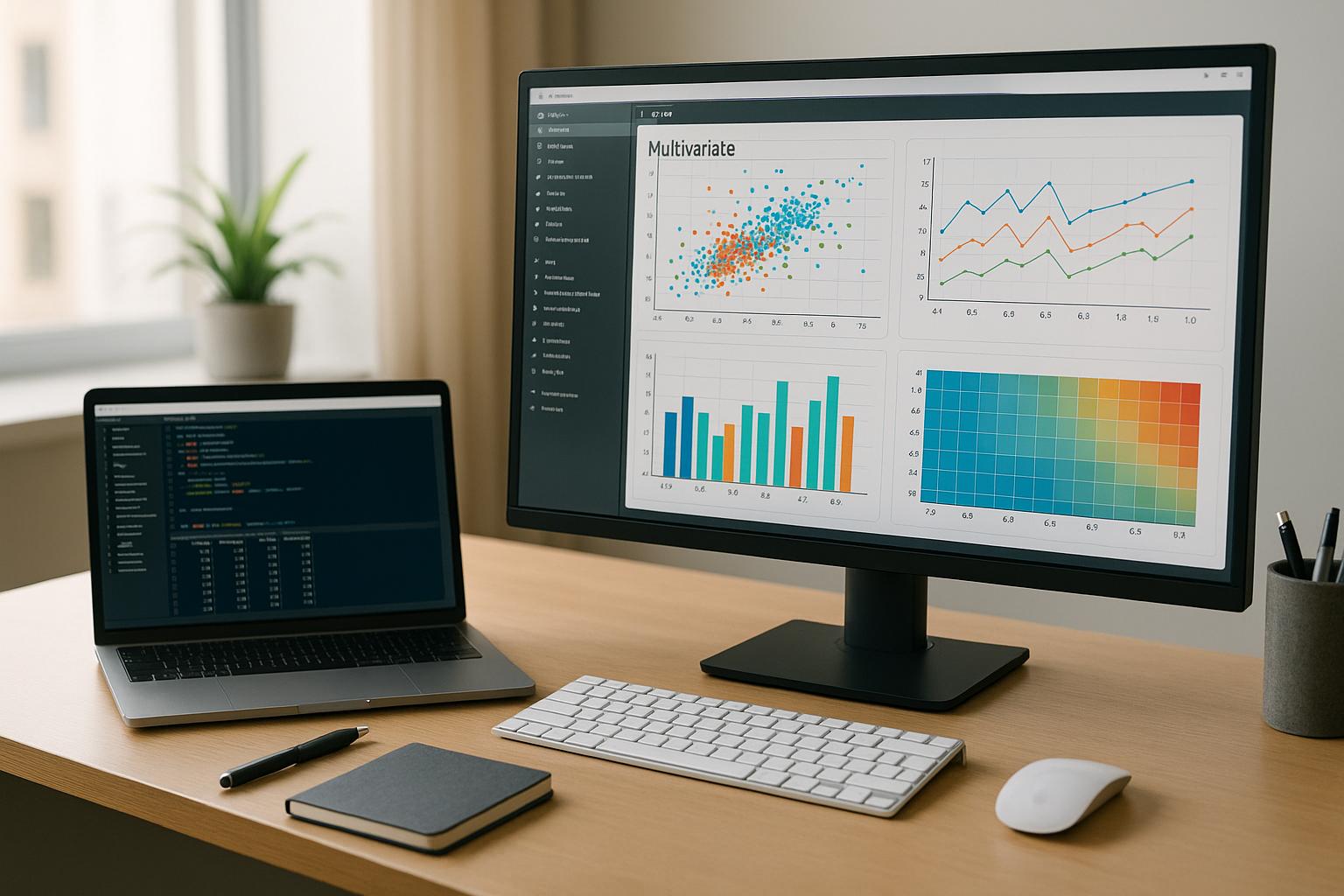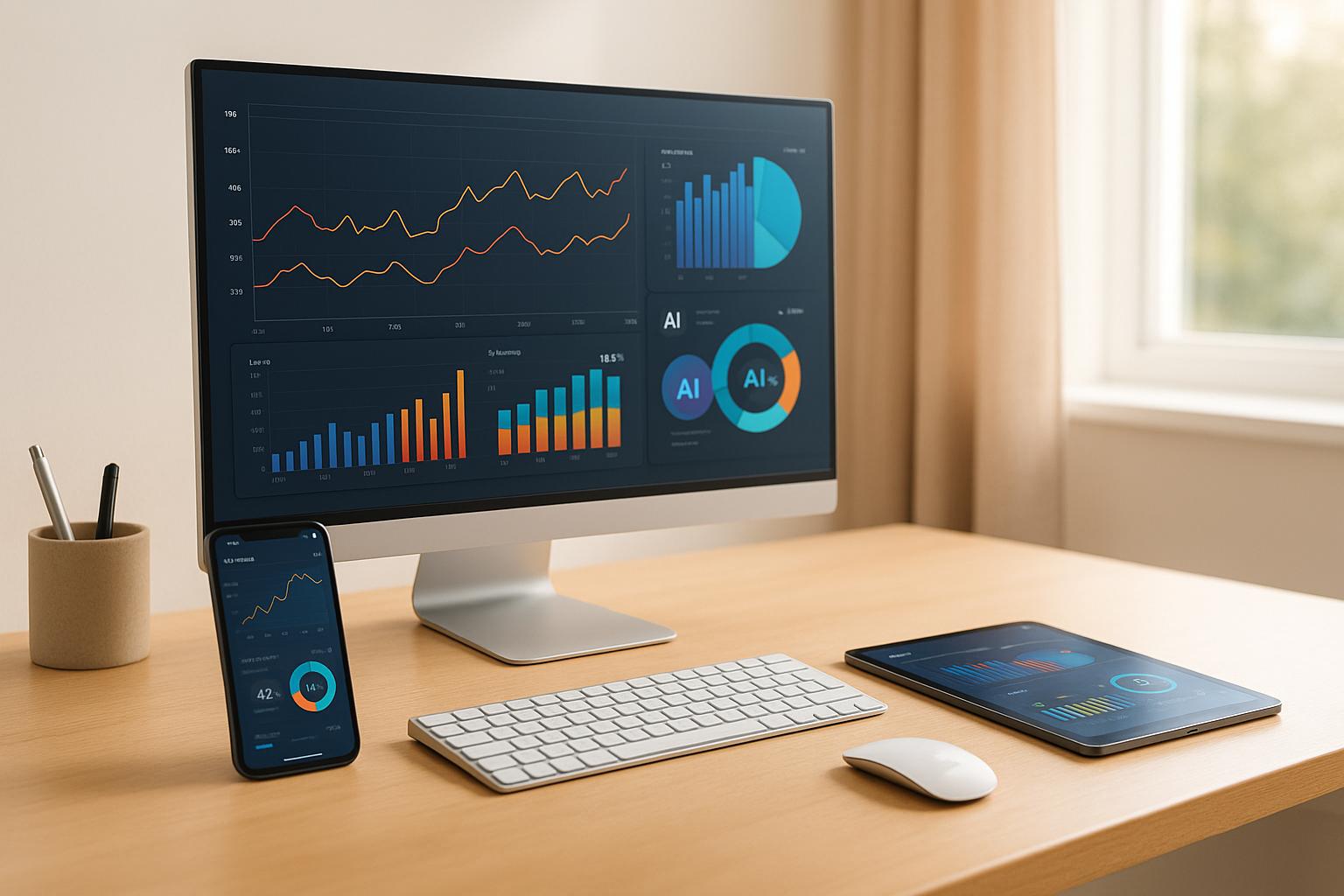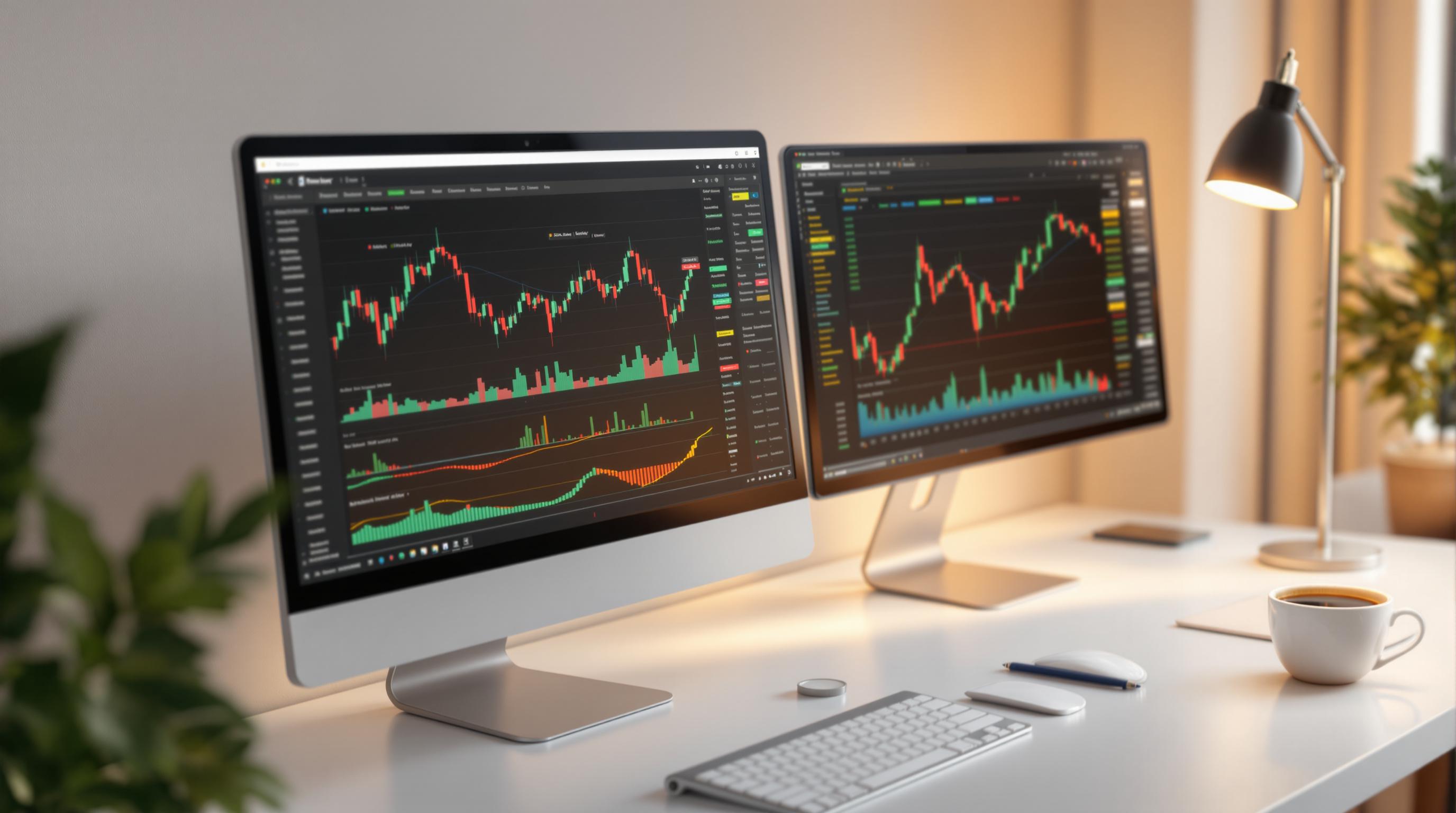Choosing between mobile and desktop trading platforms depends on your trading style and priorities. Here’s a quick breakdown:
- Mobile Platforms: Best for trading on the go. They offer portability, quick trade execution, and essential tools for monitoring positions. Perfect for casual investors or those prioritizing convenience.
- Desktop Platforms: Ideal for in-depth analysis and advanced features like multi-monitor setups, complex order types, and extensive charting tools. Suited for day traders and those requiring detailed technical analysis.
Quick Comparison:
| Feature | Mobile | Desktop |
|---|---|---|
| Portability | Trade anywhere with cellular/Wi-Fi | Requires a fixed setup |
| Charting Tools | Basic indicators, limited customization | Advanced tools, multi-chart views |
| Order Types | Market, limit, basic stop orders | Complex orders (OCO, bracket, trailing) |
| Screen Size | Small (5–7 inches) | Large (24+ inches), multi-monitor support |
| Customization | Standardized layouts | Highly customizable workspaces |
| Security | Biometric authentication, PIN codes | Firewalls, VPNs, system-level encryption |
| Internet Needs | Cellular/Wi-Fi | Wired broadband for stability |
Key Insight: Many traders use both platforms - desktop for detailed analysis and mobile for quick actions. Think about your trading frequency, need for advanced tools, and mobility to decide which suits you best.
Main Features: Mobile vs Desktop
Screen Size and Layout
The most noticeable difference between mobile and desktop trading platforms is the size of their screens and how information is displayed. Desktop platforms are designed for large monitors (usually 24 inches or more) and even support multiple screens, making it easy to view charts, orders, and other tools all at once. On the other hand, mobile platforms are built for much smaller screens, typically around 5 to 7 inches. To make the most of the limited space, they use tabbed interfaces and swipe-friendly layouts to keep things simple and organized. Interestingly, despite the smaller screen size, 55% of traders reportedly prefer mobile trading because of its portability.
Charts and Analysis Tools
When it comes to technical analysis, desktop platforms provide a much broader range of tools and customization options compared to mobile platforms. Here's a quick comparison:
| Feature | Desktop Capabilities | Mobile Capabilities |
|---|---|---|
| Technical Indicators | Over 100 with full customization options | 20–30 core indicators |
| Chart Types | Multiple types with advanced custom options | Basic chart types |
| Timeframes | Access to extensive historical data | Limited historical view |
| Layout Options | Multi-chart synchronized views | Single chart view |
| Drawing Tools | Full suite, including custom tools | Basic tools like trend lines |
While mobile platforms can't match the depth of desktop tools, they still provide quick access to essential indicators like moving averages, RSI, and MACD - all optimized for touchscreens.
Order Types and Speed
The difference in functionality becomes even clearer when looking at order execution. Desktop platforms are built to handle advanced order types, including:
- OCO (One-Cancels-Other) orders for managing complex trades
- Bracket orders with multiple target levels
- Custom trailing stops for dynamic risk management
- Conditional orders triggered by specific technical indicators
Mobile platforms, however, focus on simplicity and speed. They primarily support market, limit, and basic stop orders, which are ideal for quick decision-making, especially during fast-moving market events. A stable internet connection is critical for both platforms, but desktop setups often benefit from wired connections, while mobile platforms depend on WiFi or cellular networks.
In general, active day traders lean toward desktop platforms for their extensive features and precision, while swing traders and long-term investors may find mobile platforms perfectly adequate for their needs. Up next, we'll explore how security and connectivity play a role in shaping the user experience on these platforms.
Mobility vs Power: Platform Selection
Mobile Trading Benefits
When it comes to trading on the go, mobile platforms have transformed how traders connect with the markets. Their biggest draw? The ability to stay plugged into the action no matter where you are. Here are some of the standout advantages:
| Benefit | Description |
|---|---|
| Real-Time Access | Get instant updates and market notifications. |
| Quick Execution | A streamlined interface enables rapid orders. |
| Location Freedom | Trade from anywhere with cellular or Wi-Fi. |
| Push Notifications | Receive immediate alerts for market events. |
This level of accessibility can be a game-changer, especially during volatile market conditions. For example, swing traders can react to breaking news or sudden price shifts in real time, even if they’re away from their desks. This flexibility can make a noticeable difference in trading outcomes.
Desktop Trading Advantages
On the other hand, desktop platforms are built for traders who need more than just convenience - they’re designed for those who rely on in-depth analysis and advanced tools to execute their strategies. These platforms are a go-to for serious traders who prioritize precision and robust functionality.
Here’s what desktop platforms bring to the table:
Advanced Analysis Tools:
- A wide range of technical indicators.
- Customizable strategy-building features.
- Backtesting capabilities for refining strategies.
- Multi-timeframe analysis for deeper insights.
Professional Features:
- Support for algorithmic trading.
- Complex order types for tailored trades.
- Advanced risk management tools.
- Multi-monitor setups for better workflow.
For day traders and technical analysts juggling multiple positions, desktop platforms provide the processing power and detailed tools needed for tasks like running algorithms or managing intricate strategies. When timing and precision are everything, these platforms shine.
Many traders find that using both types of platforms strategically offers the best of both worlds. Desktops handle the heavy lifting - like detailed analysis and complex trade setups - while mobile platforms keep traders connected for monitoring and quick actions when they’re away from their primary workstation.
Security and Network Requirements
Security Measures
Trading platforms on mobile and desktop devices come with tailored security features designed to suit their unique environments. Mobile platforms often focus on user-friendly protections like biometric authentication, PIN codes, and multi-factor authentication, all backed by app-level encryption and device integrity checks. On the other hand, desktop platforms lean into system-level defenses, such as firewalls, VPNs, and secure session controls, to create a more fortified trading environment. For added safety, combining multiple layers of security is always a smart move.
| Platform Type | Common Security Features |
|---|---|
| Mobile | Biometric authentication, PIN codes, multi-factor authentication, application-level encryption |
| Desktop | Firewalls, VPNs, strong encryption methods, secure session management |
Pairing strong security measures with a dependable network connection is essential for smooth and secure trading.
Internet Connection Needs
A stable and reliable internet connection is non-negotiable for seamless trading. Mobile platforms typically rely on cellular networks (4G/5G) or consistent Wi‑Fi to handle real-time market data and execute trades without delays. Desktop platforms, however, perform best with wired broadband, which offers faster speeds and lower latency. To stay connected during unexpected network issues, many traders set up backup solutions like secondary internet connections, ensuring uninterrupted access to the markets.
sbb-itb-2e26d5a
Which Is Better? (Desktop vs Mobile Stock Trading)
Platform Settings and Tools
Once security and connectivity are in place, fine-tuning your platform settings can make your trading process smoother and more effective.
Setup Options
Desktop platforms offer a high level of flexibility, allowing traders to customize their workspace to suit specific needs. You can use multiple monitors to track various market data streams at once, arrange several charts, configure custom indicators, and assign hotkeys for faster navigation and execution. This setup provides a tailored experience for detailed and complex trading.
Mobile platforms, on the other hand, prioritize simplicity. Their standardized layouts and streamlined menus are designed for quick, on-the-go trades and market updates. While they lack the depth of customization found on desktops, they focus on delivering essential tools in a user-friendly format suitable for smaller screens.
| Customization Feature | Desktop Platform | Mobile Platform |
|---|---|---|
| Workspace Layout | Multiple monitor support; flexible arrangement | Single screen; fixed layouts |
| Chart Setup | Multiple charts; custom templates | 1–2 charts; preset templates |
| Hotkey Configuration | Extensive keyboard shortcuts | Basic touch gestures |
| Indicator Settings | Advanced customization; custom scripts | Limited presets |
Beyond these setups, tapping into advanced features can elevate your trading experience even further.
Advanced Trading Features
Desktop platforms stand out by offering a range of powerful tools for performance tracking and strategy development. These platforms support custom dashboards, detailed performance analytics, and advanced tools for creating and testing trading strategies - all features that go beyond what mobile platforms can provide.
Mobile platforms, while streamlined, focus on delivering the essentials. They ensure quick trade execution and provide real-time notifications, making them ideal for staying connected to the market when you're away from your desk. However, the gap in advanced features is notable: a recent study found that 45% of traders prefer desktop platforms for their primary trading activities due to their comprehensive capabilities.
Desktop platforms also shine in data visualization and analysis. With tools to generate performance reports, build custom dashboards, and conduct in-depth technical analysis, they are the go-to choice for traders who need detailed market insights.
For those unsure about which platform is the best fit, the Best Investing Tools Directory offers in-depth reviews of various trading platforms, helping traders find options that align with their needs and trading style.
Conclusion
Deciding between mobile and desktop trading platforms largely depends on how you trade, how often, and what tools you need. Desktop platforms shine when it comes to advanced analytics and detailed strategy building, while mobile platforms excel in convenience and quick market access.
A smart approach might combine the best of both. Desktop platforms are ideal for in-depth research, crafting strategies, and handling complex trades. On the other hand, mobile platforms are perfect for staying updated on market movements and making swift decisions when you're on the go. Think about how often you trade, whether you rely on detailed technical analysis, and how important mobility is to you.
Platforms like TradeStation and Tradytics offer solutions that blend powerful analysis tools with mobile accessibility. As trading platforms continue to advance - bringing more features to mobile apps while desktops keep their professional-grade edge - understanding these differences can help you choose the right tools to align with your trading objectives.
For detailed reviews and more insights, check out Best Investing Tools Directory.
FAQs
Should I use a mobile or desktop trading platform for my investment needs?
When deciding between a mobile or desktop trading platform, it all comes down to your trading needs and lifestyle. Mobile platforms shine when it comes to convenience, letting you monitor and manage your portfolio anytime, anywhere. They’re perfect for traders who need quick access on the go.
Desktop platforms, however, are often packed with advanced features like in-depth charting, technical analysis tools, and faster processing speeds. These are especially useful for active or professional traders who rely on detailed data and performance.
Think about your trading habits: Do you prioritize mobility, or do you need robust tools for complex strategies? Also, consider how often you need to access your account. If you're undecided, check out directories or comparison guides for trading platforms to see which one meets your investment needs best.
What security features should I look for in mobile and desktop trading platforms?
When trading on mobile or desktop platforms, keeping your investments and personal data secure should always be a top priority. One key feature to look for is two-factor authentication (2FA). This adds an extra hurdle for unauthorized access by requiring a second form of verification beyond just your password.
Another must-have is encryption protocols like SSL, which protect your information during transactions. Platforms that provide regular software updates are also essential, as these updates fix security gaps that could be exploited. For added peace of mind, choose platforms that let you set up customized alerts for any unusual activity. These alerts keep you informed in real time, allowing you to act quickly if something seems off.
Can I use mobile and desktop trading platforms together effectively?
Yes, you can make the most of both mobile and desktop trading platforms by taking advantage of their individual strengths. Desktop platforms excel when it comes to detailed analysis, advanced charting, and handling complex trades. Their larger screens and comprehensive tools make them ideal for deep dives into market trends and planning strategies.
Mobile platforms, however, shine when it comes to convenience. They let you keep tabs on the market and execute trades no matter where you are.
For the best results, consider using your desktop for in-depth research and planning, while your mobile platform can handle quick updates, alerts, and time-sensitive trades when you're on the move. Many brokers also offer synced data across devices, so you can switch between your desktop and mobile seamlessly.



